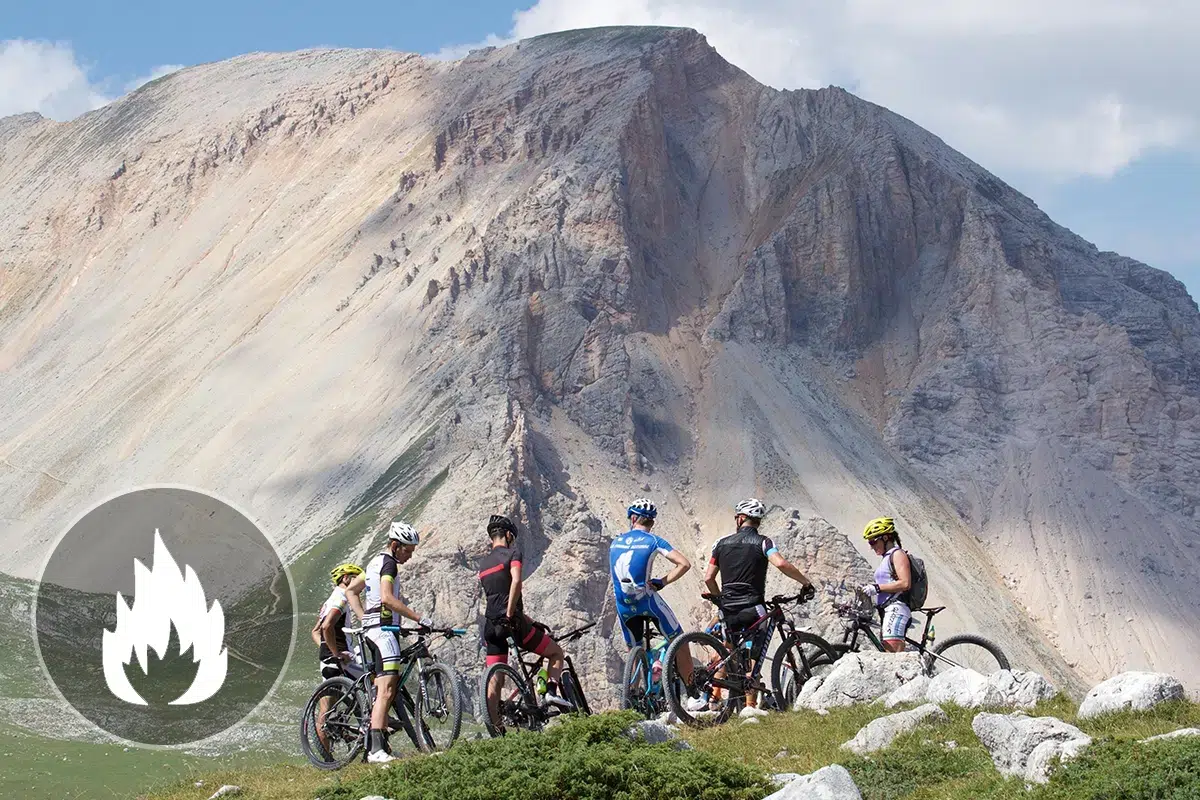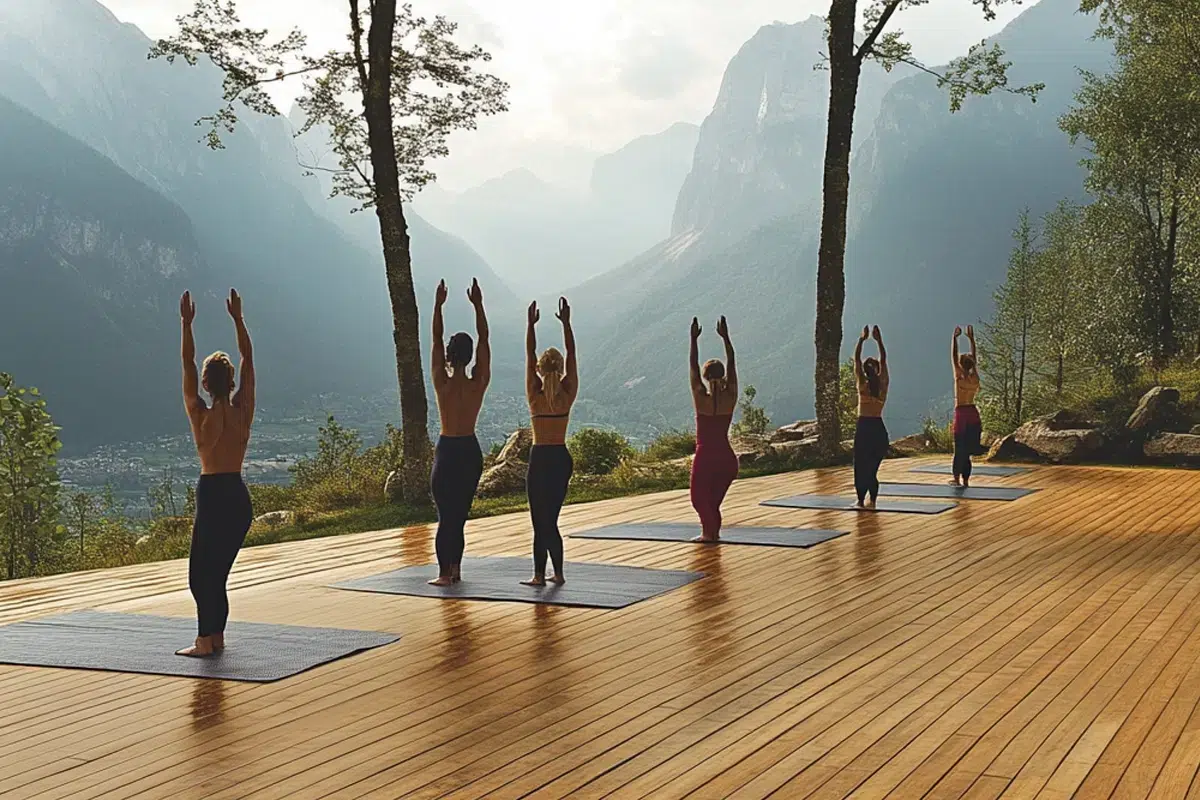Show summary Hide summary
How many calories do we burn mountain biking?

Everything you need to know about mountain biking
🚵 Wondering how many calories you burn mountain biking for 30 minutes or 1 hour? Fill in your session time and profile to get an estimate from our tool.
Discover other REGIVIA calculators:
Mountain biking: A few examples of energy expenditure depending on weight and activity time.
Use the table below to see how many calories you lose by mountain biking!
Mountain biking
Normal intensity
Kilocalorie expenditure
| Weight | 15 minutes | 30 minutes | 1 hour |
|---|---|---|---|
| 40 kg | 95 | 189 | 378 |
| 50 kg | 118 | 236 | 473 |
| 60 kg | 142 | 284 | 567 |
| 70 kg | 165 | 331 | 662 |
| 80 kg | 189 | 378 | 756 |
| 90 kg | 213 | 425 | 851 |
See detailed calculations and metabolic equivalent for mountain biking
Everything you need to know about mountain biking
FIND OUT MORE ABOUT MOUNTAIN BIKING
Mountain biking is an all-round sport that can be practised in any setting. That’s the big advantage of mountain biking, which, as its name suggests, is an all-terrain sport, so you’ll have no problem getting out on the trails, in the woods or in any other natural setting.
On the downside, it doesn’t offer the speed advantages of a road bike. That’s why, in recent years, we’ve seen the emergence of the VTC (mountain bike) or the Gravel bike , which offers a better blend of road and nature.
The mountain bike will build your muscles harmoniously and help your figure to dry out. It will be a real ally for those who want to develop their aerobic capacity while burning a lot of calories, especially if you live in steep areas.
Whether it’s for exploration, adrenaline or simply to stay in shape, mountain biking is an exciting activity with many benefits.
Some benefits of mountain biking:
- Improved physical fitness: Mountain biking is an all-round sport that uses many of the body’s muscles. Pedalling over varied terrain, climbing hills and descending trails requires an intense cardiovascular effort and strengthens the muscles of the legs, arms and trunk. This helps to improve endurance, strength and stamina.
- Muscle strengthening: Mountain biking mainly involves the leg muscles, such as the quadriceps, hamstrings and calves. However, it also works the muscles of the upper body, particularly the arms, shoulders and back muscles, thanks to the need to maintain balance and control the bike on difficult terrain.
- Improved balance and coordination: Mountain biking requires excellent coordination between pedalling, braking, changing gears and controlling the bike over varied terrain. This encourages the development of balance, motor coordination and proprioception.
- Mental stimulation: Mountain biking requires constant attention to anticipate obstacles, choose the right trajectories and react quickly to changes in terrain. This stimulates concentration, decision-making and mental reactivity.
- Exploring nature: Mountain biking lets you explore magnificent natural trails and landscapes. It’s a great way to connect with nature, enjoy the fresh air and discover new places off the beaten track.
- Stress reduction: Mountain biking is an intense activity that releases accumulated stress and tension. Riding in the middle of nature, concentrating on the sport and enjoying the beauty of the countryside all contribute to a feeling of well-being and relaxation.
- Sociability: Mountain biking can be enjoyed in groups, which encourages sociability and the sharing of experiences. Riding with friends or joining mountain biking clubs or events is a great way to bond socially and share a common passion.
Whether you’re a beginner or an experienced rider, mountain biking offers a complete and exciting sporting experience. It’s important to get the right bike, follow the safety rules and choose the right routes for your level of ability. Regular mountain biking allows you to progress, improve your physical condition and enjoy moments of adventure and pleasure in the great outdoors. However, it’s essential to always pay attention to safety, wear appropriate protective equipment, maintain your bike and respect the natural environment on every outing. Mountain biking is much more than just a sport, it’s a genuine experience of freedom, of pushing yourself to the limit and of communing with nature. So get on your bike, explore new trails and enjoy the physical and mental benefits that mountain biking has to offer.
How to calculate the number of calories burned mountain biking
The result displayed is expressed in Kcal and is calculated using the MET (Metabolic Equivalent of Task). The MET for each activity is the result of statistical data and cannot therefore be interpreted as an exact calculation, but rather as an estimate that takes into account the MET value and the ratio between the time spent doing an activity and the weight of the individual.
For example: The MET value for mountain biking is 9. This means that a person who practices mountain biking consumes 9 times more energy than at rest when cycling on all types of terrain.
Discover the detailed formula to calculate your daily energy expenditure while mountain biking
Consumption in Kcal per minute = (METs*3.5*Weight in kilos)/200
For someone weighing 70 kilos and riding a mountain bike for 30 minutes:
Consumption in Kcal per minute = (9*3.5*70)/200 = 11.025 Kcal/min
So for 30 minutes = 11.025*30 = 330.75 kcal for 30 minutes
All sports in detail!



















































